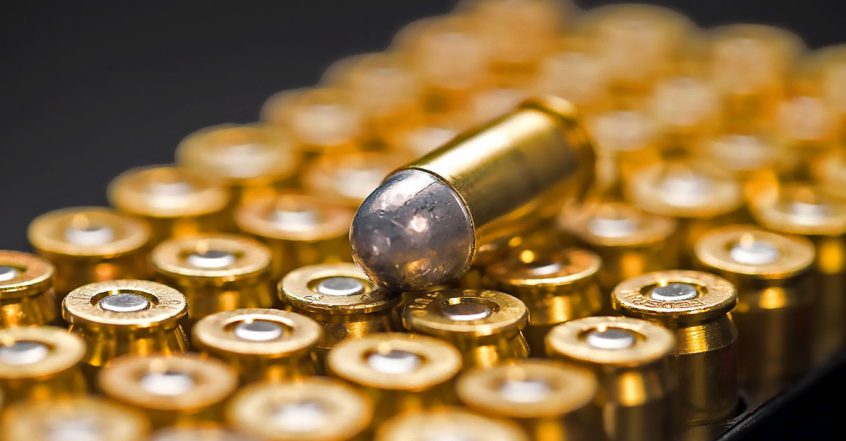How can you Help Firearms United in fight against #EUAmmoBan
Firearms United asks for your help: If you have/know/can find any studies about lead, we would be interested to know about them.
Please send us links to any studies you may find via our Firearms United Network FB page. If study is in your native language, please add a short summary about study subject and conclusions. The goal is to collect all the relevant study material.
Main arguments for EU #Ammoban are the following:
[1] Health risks posed by lead to humans through the consumption of game meat (lead contaminates meat near wound channel).[2] Large-scale contamination of wetlands with thousands of tonnes of lead disposed annually from the use of lead gunshot for is clear.
[3] lead poisoning of waterbirds through the ingestion of spent lead pellets results in the mortality of approximately one million waterbirds per year in the EU.
[4] The use of lead gunshot in terrestrial/wetland areas can lead to the lead poisoning of various species in terrestrial areas, including predators and scavengers affected through secondary poisoning (predator eats prey that has elevated lead levels or hunters leave intestines with lead shot to nature where other animals consume it)
[5] Home ‘casting’ of various types of lead-based fishing tackle/bullets for recreational anglers/shooters appears, based on the predominance of online retailers, to be widespread. The risks of this practice could also be addressed by further regulatory action.
[6] Shooting ranges using lead shot represent a significant risk of soil contamination in terrestrial areas, and risk contaminating nearby (ground) water sources in the EU.
[7] Alternatives to lead gunshot ammunition are available (mainly steel, bismuth and tungsten as with lead in shot in wetlands). (Note: Funny – nobody is banning cars, even though most people can walk…)
[8] There could be an added value in setting minimum risk management measures (RMMs) for lead exposure and emission control at shooting ranges.
[9] Because lead is bad: Lead is a toxic heavy metal – non-threshold substance, having negative effects on general health, reproduction and behavior.
Because knowledge can be weaponized and right person having the right information on the right moment can make all the difference.
Here are studies and short summaries about which EU arguments they can be used to against.
1. The Spanish Study:
Extremely extensive and recent (and therefore valid) study in European scale about the impact of lead to birds. Study has large sample size where over 530 birds have been captured and analyzed to see whether they had ingested lead pellets mistaken for grains and bird food. Study contains extensive analysis of birds and how the lead impacts them, including analysis of brain, kidneys and liver.
Main findings:
- There were only very very tiny amounts of lead (<1,5 tai 0,65 ppm) found in less than 2% of game birds. All birds were in healthy condition and behaving normally.
- The birds analyzed were brought down using lead ammunition (because it was hard to get non-lead ammunition) and the still the amount of the lead in the system was practically non-existent. Common part is 1,5 micrograms/kg, which can be exceeded in waterfowl species, but this concentrated on terrestrial birds and this threshold was not exceeded. 95% of the analyzed birds were actually under 0,65 micrograms/kg and only very very tiny portion of birds hand ingested lead shot.
Useful against EU arguments [3] and [4]
Source: http://federacionarmera.com/estudio-del-plomo/
2. Ramboll (Consulting company) study about behavior of lead in shooting range soil
This recent study by a consulting company mainly concentrates on finding a reliable test pattern to predicts the contamination of soil on shooting ranges in case replacement materials for lead shot are used on shooting ranges that already have been used to shoot lead shot, and environmental impacts of materials other than lead used to replace lead as a material.
Main findings:
- Lead shot reacts with environment by generating a thin layer of oxidization which significantly slows down the breakdown of lead pellets. As a result lead does not cause large scale contamination of the soil and typically remains in the top layer of the soil.
- Steel shot used in conjunction with lead can increase the breakdown rate of lead. In some cases, corrosion of lead pellets increased to 6,3 times due to impact of iron oxide and in addition to that, manganese and nickle amounts were raising in some samples
- The combined effect of lead and materials to replace lead is extremely complex to estimate and there is a significant amount of complex variables involved such as soil type, temperature variations, PH of the soil and so on. Therefore lead should be seen as a safe option, because it remains in the top soil, which can be replaced later when and if area is for example zoned for building houses.
Useful against EU arguments [6] and [7]
3. Risk Evaluation of Impact of Lead on Soil, Health and Groundwater at Outdoor Shooting Range (Thesis work)
High quality thesis work to evaluate risks that the lead, which is shot at the shooting range, causes to health, soil and groundwater. The second purpose of the thesis was to find out how to minimize risks that lead brings to ecology and if the soil is contaminated with lead how it can be cleaned in a proper way.
Main findings:
- The normal level of lead in Finnish soil is about 17 mg/kg
- Allowed lead content for drinking water is 10 μg/liter defined by THL.
- The lower the PH of the soil, the higher the rate of lead dissolving into the ground. In neutral or alkaline soil lead is practically stable substance.
- Only very thin layer of top soil (10 cm) is contaminated on shooting range area even though range has been in use since 1988 because lead is stable substance. If lead is used in rifle bullets which typically have a copper or metal jacket, lead is not exposed to elements and dissolves very slowly if at all. When bullet hits the backstop it can deform and expose lead core. Jacket still partially covers the bullet and the exposed part reacts and forms a layer of oxidization which further slows down dissolving of the lead. Also “grain” size with bullets is significantly larger than shotgun pellets which means that exposed surface area/weight of the lead is lot smaller, thus bullets have significantly smaller risk of contaminating the soil. Bullets are also typically shot to a backstop where they are buried, unlike pellets that are used to shoot aerial targets (skeet, trap) where pellets are dispersed to a larger area and temporarily exposed to elements until oxidized layer has been formed around the lead core of the pellet.
- When animals are exposed to lead, lead ends up into bones. If small animals ingest lead pellets, the lead does not proceed through the food chain because predators do not eat or digest bone material where the lead mostly ends up in the pray.
- Ground water contamination can be easily monitored should there be a need for it.
- In this study samples collected from the shooting range area found that there were few spots where (top 10 cm) soil was slightly contaminated by lead, but this was not causing risk for ground water. However, there were elevated levels of nickel found from the ground water, but that was caused by levels of nickel typically found in the soil of the area and the shooting range had nothing to do with it.
- Moving to replacement materials is bad because sport shooters compete in sports where they have to shoot with lead shot. When shooting range bans use of lead shot, the nationally and internationally significant competitions and competitors move away from the range or the area. This has already been seen in Sweden.
- All risks for ground water contamination with lead was found tolerable because even if lead can dissolve the probability for it is highly unlikely. Risk of lead+replacement materials contaminating ground water as seen as insignificant.
Useful against EU arguments [4], [6] and [7]
Source: https://www.theseus.fi/bitstream/handle/10024/29116/Leiviska_Mikko.pdf?sequence=1
4. Risk Analysis – Former Shooting Range area Svärdfelt by FCG (Consulting Company)
Risk analysis commissioned by city on an area which had seen extensive use as a shooting range for both lead shot and bullets. Study and extensive analysis had been conducted by consulting company FCG from samples taken in the range area during autumn 2012. Earlier studies had found elevated levels of lead and the area was re-zoned for housing purposes so the extent of soil contamination had to be studied more closely. Area had been used as a shooting range for rifles (small and big bore) between 1967-1983 and as a shotgun range between 1973 and 1983. There are three values which are considered for soil contamination: threshold value, lower and higher value. Soil is considered clean when threshold(or natural background value) value is not exceeded. When value of a contaminant exceeds lower value, it is considered contaminated for housing purposes for example. When value of contaminant exceeds higher value area can be considered contaminated for industrial and other purposes.
For there to be any risk of health hazard, 3 factors must come together:
- Contaminant must be present in harmful amounts
- There needs to a recipient for lead exposure (people or animals)
- Method of transportation for the contaminant to travel from the environment to the recipient
While there was contaminant present, and recipient, the method of transportation was missing and therefore lead did not cause excessive risk to people or animals in the area.
Main findings:
- There was no values that exceeded threshold below the top soil (deeper than 0,2 to 0,4 meters). Any contamination from bullets and lead shot remains in surface soil only because lead is not very active or easily dissolved to soil.
- The lower the PH of the soil, the higher the rate of lead dissolving into the ground.
- Any contaminatino of surface or ground water is not expected to be happening.
- Consuming surface soil from shooting range leads to increased exposure to lead and other heavy metals.
- Contaminated shooting range areas can be cleaned by replacing or cleaning the top soil layer. The contamination is limited on the very thin layer on top, and when using leads as bullets then bullets are ending up in the earth berm behind target or specifically manufactured lead traps (depending on the range) and therefore contamination can easily be monitored and managed.
Useful against EU arguments [6]
Source: https://www.sipoo.fi/easydata/customers/sipoo/files/2011_keke/nikkilankartano/selvitykset/svardfelt_riskinarviointi.pdf


 English
English Deutsch
Deutsch Italiano
Italiano Français
Français Español
Español suomi
suomi Polski
Polski Eesti
Eesti Português
Português Svenska
Svenska Română
Română
One Comment on “Studies: Lead in Ammunition”
Ich verstehe eines nicht:
In der “Anex XV iInvestigation report” der ECHA Punkt 2.2 the ECHA wurde geschrieben:
2.2. Lead for shooting purposes
Lead may constitute a health risk at firing ranges. However, this as such may not
necessarily warrant action in terms of a restriction on the use of lead bullets. Other sorts
of action under e.g. the Chemical Agents Directive may achieve the same goal and should
be considered under a risk management options analysis.
Prevention includes changing clothing after shooting, behavioural modifications such as
banning of smoking and eating at firing ranges, improved ventilation systems and
oversight of indoor ranges, and development of airflow systems at outdoor ranges.
Emissions to the environment can be adequately dealt with by range-design and ensuring
entrapment of bullets and spent shot. Eliminating lead dust risk at firing ranges requires
primary prevention and using lead-free primers and lead-free bullets.
Das heisst es rechtfertigt keine Aktion auf diesem Gebiet !
Wieso treibt die EU Kommission trotzdem (gegen die E,pfehlungen des eigens angeforderten Gutachtens der ECHA !!) ein generelles Verbot von bleihaltiger Munition (Auch auf Schiessstànden) voran ??